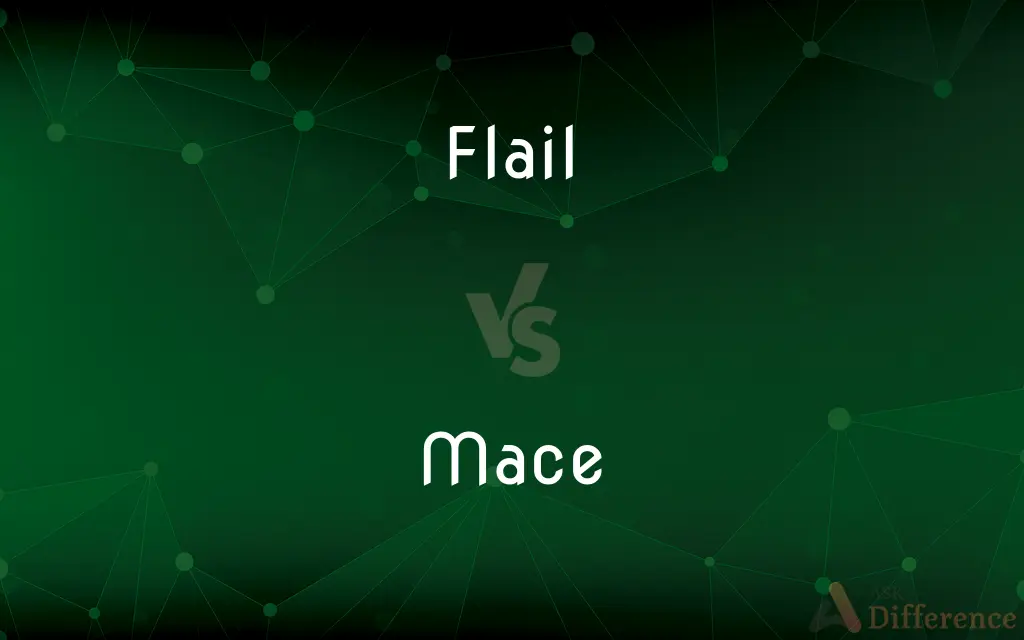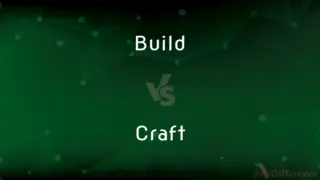Flail vs. Mace — What's the Difference?
By Maham Liaqat & Urooj Arif — Updated on March 27, 2024
A flail features a swinging head connected by chain to a handle, emphasizing motion, while a mace is a solid club with a fixed, often spiked head for direct impact.

Difference Between Flail and Mace
Table of Contents
ADVERTISEMENT
Key Differences
A flail is characterized by its unique design, consisting of a handle connected to one or more striking heads by chains or flexible links. This allows the head to swing freely and gain momentum before striking, making it effective at overcoming shields or armor. Conversely, a mace is a simpler weapon in design, comprising a sturdy handle with a fixed head, often made of metal and sometimes adorned with flanges or spikes to enhance its lethality.
The swinging motion of the flail's head requires skillful handling to avoid self-injury, underscoring the weapon's complexity and the need for training in its use. The mace's construction makes it a robust and reliable weapon for close combat, capable of delivering powerful blows that can crush armor and inflict severe damage. Its ease of use compared to the flail made it a popular weapon among infantry and knights alike.
The flail's flexibility and the momentum it can generate allow for a dynamic range of attacks, including the ability to strike around shields or parries. This unpredictability and the ability to inflict blunt trauma from different angles made the flail a formidable weapon against opponents in plate armor or behind cover. The mace, on the other hand, relies on the brute force of direct hits, with its design focused on maximizing the impact at the point of contact. The weight distribution and the solidity of the mace head contribute to its effectiveness in breaking through armor and causing concussive force, making it especially useful in frontal assaults.
In terms of historical usage, the flail began as an agricultural tool before being adapted for warfare, particularly in the Middle Ages. Its evolution into a weapon of war reflects the innovation in military tactics and the need to address the challenges posed by improved defensive armaments. The flail's distinctive appearance and its association with warfare have also made it a symbol of authority and power in certain cultures. The mace, with its ancient origins and continued use through various historical periods, serves as a testament to the enduring value of simplicity and efficiency in weapon design. Its presence in various cultures, from the ancient Near East to medieval Europe, highlights its role as a symbol of military power and noble rank, further solidifying its place in the history of warfare.
Comparison Chart
Design
Handle with one/more heads connected by chain
Solid club with a fixed head
ADVERTISEMENT
Mode of Attack
Swinging motion for momentum
Direct impact with force
Complexity
Requires skill and practice to use effectively
Simpler and more intuitive to use
Historical Use
Adapted from agricultural tool for warfare
Ancient weapon, used throughout history
Symbolism
Authority, power, and innovation in warfare
Military power, noble rank, and reliability
Compare with Definitions
Flail
A medieval weapon with a swinging head attached by chain.
The knight wielded a flail, its head whirling menacingly.
Mace
A heavy club with a fixed, often spiked head.
The warrior's mace crashed through the armor of his foe.
Flail
Designed for flexibility in combat.
The flail allowed soldiers to strike around enemy shields.
Mace
Used for direct, powerful strikes.
In close combat, the mace proved to be devastatingly effective.
Flail
Evolved from agricultural tools.
The flail's origins as a grain threshing tool were still evident in its design.
Mace
Symbol of power and nobility.
The king's scepter, resembling a mace, symbolized his authority.
Flail
Symbol of authority in certain cultures.
Ceremonial flails were symbols of power and justice in ancient ceremonies.
Mace
Predates the flail in historical use.
Ancient civilizations used maces in battle and as symbols of power.
Flail
Requires careful handling due to its design.
Mastering the flail took years of practice.
Mace
Simple yet effective weapon design.
The simplicity of the mace made it a reliable weapon for soldiers.
Flail
A flail is an agricultural tool used for threshing, the process of separating grains from their husks. It is usually made from two or more large sticks attached by a short chain; one stick is held and swung, causing the other (the swipple) to strike a pile of grain, loosening the husks.
Mace
A staff of office, especially that which lies on the table in the House of Commons when the Speaker is in the chair, regarded as a symbol of the authority of the House.
Flail
A threshing tool consisting of a wooden staff with a short heavy stick swinging from it.
Mace
A heavy club with a spiked metal head.
Flail
Wave or swing wildly
His arms flailed as he sought to maintain his balance
Mace
The reddish fleshy outer covering of the nutmeg, dried as a spice.
Flail
Beat or flog (someone)
He escorted them, flailing their shoulders with his cane
Mace
Spray (someone) with Mace
Three individuals were Maced by an unknown male
Flail
A manual threshing device consisting of a long wooden handle or staff and a shorter, free-swinging stick attached to its end.
Mace
A ceremonial staff borne or displayed as the symbol of authority of a legislative body.
Flail
To beat or strike with or as if with a flail
Flailed our horses with the reins.
Mace
A macebearer.
Flail
To wave or swing vigorously; thrash
Flailed my arms to get their attention.
Mace
A heavy medieval war club with a spiked or flanged metal head, used to crush armor.
Flail
To thresh using a flail.
Mace
A thin fleshy red covering that surrounds the kernel of the nutmeg, dried and used as a spice.
Flail
To move vigorously or erratically; thrash about
Arms flailing helplessly in the water.
Mace
A heavy fighting club.
Flail
To strike or lash out violently
Boxers flailing at each other in the ring.
Mace
A ceremonial form of this weapon.
Flail
To make energetic but aimless or or ineffectual efforts
"As the end of law school approached, Hill flailed briefly in numerous professional directions" (Molly Worthen).
Mace
A long baton used by some drum majors to keep time and lead a marching band. If this baton is referred to as a mace, by convention it has a ceremonial often decorative head, which, if of metal, usually is hollow and sometimes intricately worked.
Flail
To thresh grain.
Mace
An officer who carries a mace as a token of authority.
Flail
A tool used for threshing, consisting of a long handle with a shorter stick attached with a short piece of chain, thong or similar material.
Mace
A knobbed mallet used by curriers make leather supple when dressing it.
Flail
A weapon which has the (usually spherical) striking part attached to the handle with a flexible joint such as a chain.
Mace
(archaic) A billiard cue.
Flail
(transitive) To beat using a flail or similar implement.
Mace
An old money of account in China equal to one tenth of a tael.
Flail
(transitive) To wave or swing vigorously
Mace
An old weight of 57.98 grains.
Flail
(transitive) To thresh.
Mace
A spice obtained from the outer layer of the kernel of the fruit of the nutmeg.
Flail
(intransitive) To move like a flail.
He was flailing wildly, but didn't land a blow.
Mace
Tear gas or pepper spray, especially for personal use.
Flail
An instrument for threshing or beating grain from the ear by hand, consisting of a wooden staff or handle, at the end of which a stouter and shorter pole or club, called a swipe, is so hung as to swing freely.
His shadowy flail hath threshed the corn.
Mace
To hit someone or something with a mace.
Flail
An ancient military weapon, like the common flail, often having the striking part armed with rows of spikes, or loaded.
No citizen thought himself safe unless he carried under his coat a small flail, loaded with lead, to brain the Popish assassins.
Mace
To spray in defense or attack with mace (pepper spray or tear gas) using a hand-held device.
Flail
An implement consisting of handle with a free swinging stick at the end; used in manual threshing
Mace
(informal) To spray a similar noxious chemical in defense or attack using an available hand-held device such as an aerosol spray can.
Flail
Give a thrashing to; beat hard
Mace
A money of account in China equal to one tenth of a tael; also, a weight of 57.98 grains.
Flail
Move like a flail; thresh about;
Her arms were flailing
Mace
A kind of spice; the aril which partly covers nutmegs. See Nutmeg.
Mace
A staff borne by, or carried before, a magistrate as an ensign of his authority.
Mace
An officer who carries a mace as an emblem of authority; a macebearer.
Mace
A knobbed mallet used by curriers in dressing leather to make it supple.
Mace
A rod for playing billiards, having one end suited to resting on the table and pushed with one hand.
Mace
A chemical preparation containing tear gas in a solvent, packaged in the form of a spray, and used to temporarily incapacitate people, such as rioters or criminals, by causing intense eye and skin irritation; also called chemical mace. It is designed to be a non-lethal weapon for defending against violent people.
Mace
(trademark) a liquid that temporarily disables a person; prepared as an aerosol and sprayed in the face, it irritates the eyes and causes dizziness and immobilization
Mace
An official who carries a mace of office
Mace
Spice made from the dried fleshy covering of the nutmeg seed
Mace
A ceremonial staff carried as a symbol of office or authority
Common Curiosities
Can both flails and maces penetrate armor?
Yes, both are designed to combat armor, with flails striking from multiple angles and maces applying direct force to break or dent armor.
What is a flail?
A flail is a weapon consisting of one or more heads attached by chain to a handle, designed to be swung to strike opponents.
What is a mace?
A mace is a heavy club with a fixed head, often adorned with spikes or flanges, used for direct combat.
How do flails and maces differ in combat?
Flails are swung to generate momentum for strikes, capable of hitting around defenses, whereas maces deliver direct, forceful blows.
Which requires more skill to use effectively, a flail or a mace?
A flail requires more skill and practice due to its complex design and the risk of self-injury during use.
How did the design of flails and maces evolve over time?
Both evolved with advancements in armor and warfare, with flails becoming more sophisticated and maces more durable and impactful.
Were flails and maces used by specific classes of warriors?
Both were used across various social classes of warriors, though maces were often associated with nobility and flails with specialized infantry.
Do flails have any symbolic meanings?
Yes, in some cultures, flails symbolize authority, power, and the ability to mete out justice.
What role did maces play in ceremonial contexts?
Maces served as symbols of authority and power in ceremonies, used by royalty and high-ranking officials.
Are flails and maces still used today?
They are primarily ceremonial or collectible items today, though their historical significance remains a topic of interest.
How did warriors train to use flails effectively?
Training involved mastering balance, timing, and spatial awareness to wield flails without injuring oneself and to strike accurately.
Is there a difference in the weight between flails and maces?
Generally, maces are heavier due to their solid construction, while flails may vary in weight depending on the head and chain length.
What materials were historical maces made from?
Maces were made from various materials, including wood, metal, and stone, depending on the era and region.
Did any specific cultures prefer flails over maces?
Preferences varied, with some European and Asian cultures utilizing flails for their tactical advantages in certain periods.
Can flails be dual-wielded?
While theoretically possible, dual-wielding flails would require exceptional skill due to the increased risk of self-injury and the complexity of managing two swinging weapons simultaneously.
Share Your Discovery

Previous Comparison
Commendable vs. Excellent
Next Comparison
Build vs. CraftAuthor Spotlight
Written by
Maham LiaqatCo-written by
Urooj ArifUrooj is a skilled content writer at Ask Difference, known for her exceptional ability to simplify complex topics into engaging and informative content. With a passion for research and a flair for clear, concise writing, she consistently delivers articles that resonate with our diverse audience.














































